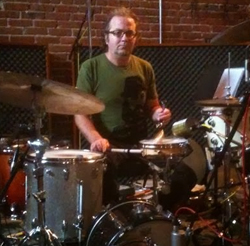Anyone who reads me regularly knows how much I love, admire and respect great drummers. My good buddy Brian MacLeod certainly falls into this category, having been the pulse behind recordings of Sheryl Crowe, Madonna, Christina Aguilera, Seal, Ziggy Marley and many more.
I remember the first time I heard Crow’s “All I Wanna Do” at a party as it was climbing the charts, and the only thing I could think about was “Wow, does the drummer ever groove on this.” And that’s exactly what Brian does—make the song groove and feel good in a way that few can.
Here’s an excerpt from an interview with Brian from The Drum Recording Handbook (which was written with the great engineer Dennis Moody) where he talks about playing to a click and gives some great advice.
There’s a defining moment for every player when they finally “get it.” What was yours?
Brian McLeod: That’s an interesting moment for me. I think it was on my first trip to LA on my first kind of big session. It was with Patrick Leonard (producer for Madonna, Rod Stewart, Jewel, Bon Jovi, Elton John and Pink Floyd among others). He flew me down from San Francisco, where I was teaching drums and playing live. I had toured a bit and done a few albums in England at that point. Pat was starting a band and was auditioning me to be the drummer.
Now this is back in the days of tape. He played me a track, which was already finished, that had a click. I played that song and then another and he said, “Hey Brian, can you come in here for a minute” [to join him in the control room]. I thought to myself, “That’s my audition. I guess I’m outa here,” so I actually grabbed my stick bag and zipped it up so I wouldn’t have the embarrassment of having to walk back out into the studio to get it. I figured that the door out of the studio was in the control room and if he was firing me, I just wanted to be able to leave as fast as I can.
I zipped up my stick bag and walked into the control room and he looked at it with a confused look on his face, like “What are you doing?”. So I go, “What’s up?” and he says, “I love the way you play to the click. You know how to lock in without making it sound mechanical. I want to hire you to do this record.” Then he says, “Oh, by the way, listen to a track I just finished,” and he cranks up Madonna’s “Like A Prayer” at full volume. That was the moment I felt like, “Wow, I think I get this.” I realized at that moment that I really could play to a click and make it breath at the same time, and that really is an important thing for drummers to learn. If you play to a click, don’t be so focused on it that you lose sight of the fact that your actually playing a song.
What are you looking for in the phones when you record?
That’s a great question. Generally it depends on how we’re tracking. If I’m tracking with a bass player and we’re doing overdubs to an existing track, I’ll try to get a nice even level so it sounds like a record with the vocals and the bass player just above the music. I want to hear the bass player so I can be sure to lock my kick drum with him. Then if I’m tracking live I want whoever is the leader of the song to be above the track. Like if the guitar player has written the song, he might be doing some important inflections that I need to hear. If it’s a vocalist who has written the song and they’re evoking some emotion that they really want, I’ll make sure that is above everything else. So I latch on to whatever the main instrument of the tracking date is, or what is the biggest concern seems to be when laying down the basics.
I’ll also have the click at an ungodly level, which can drive producers and engineer’s crazy, so I like to use closed headphones for that. I’m still looking for the perfect set of headphones because you don’t want the click track leaking into the song. On Christina Aguilara’s “Beautiful,” you can hear a bit of the drum machine on her vocal track, but the vocal was so amazing that they just went with it. You have to be careful especially on endings of songs. I try to get the engineer to cut the click off so that the cymbal sustain doesn’t have any click bleed. I’ll even punch in the ending of a song if they can’t catch it at the right time.
What kind of a click sound do you like?
In the old days I used to be very specific about it. I used to like a cowbell or some sort of side-stick sound with a shaker doing 16ths or 8ths depending on the feel of the song. I have to say that’s still my favorite click track, but I’m getting used to just the Protools click. I’ve adjusted over the years, but my preference still is the cowbell and shaker.





















